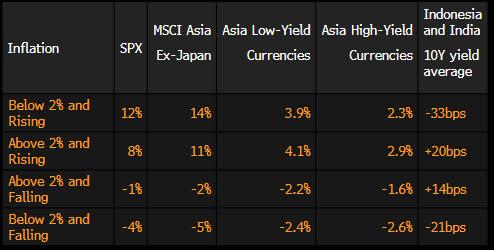In Praise Of Inflation, Or What Risk Assets Need
Tyler Durden
Wed, 08/19/2020 – 14:55
By Simon Flint, an emerging-market strategist at Bloomberg News
For investors worried that rising inflation expectations may derail risk assets, history offers plenty of reassurance. If you studied economics as long ago as I did, you have to shake off an ingrained conviction that inflation can breed great evil: the era of low and stable inflation has proved the opposite.
Most importantly, higher inflation expectations can reduce real yields, as my colleague Ye Xie has pointed out. They also imply greater corporate pricing power.
Both factors benefit equities. The following table shows both the S&P 500 and MSCI Asia-Pacific indexes have performed well during such periods. I took daily data from 2004 to the present, and created four sample scenarios for inflation expectations, then examined the performance of equities, currencies and Asia’s two main high-yield EM bond markets: India and Indonesia.
I split the data into periods over which 10-year U.S. breakevens moved significantly (27-70bps) during a fairly short timespan (15-129 days). I then excluded periods when nominal rates moved in the same direction as break-evens by a factor of greater than 1.5 – it was almost always much less – to try and eliminate the times when rising growth expectations dominated. The periods chosen have significant overlaps with the times when University of Michigan surveys showed 5-10 year inflation expectations were rising.
The four samples were divided into periods when breakevens were:
-
below 2% and rising (4 occasions),
-
above 2% and rising (5),
-
above 2% and falling (5),
-
and below 2% and falling (6).
I excluded the Global Financial Crisis and the post-Covid shock.
The results were then scaled to the equivalent of a 100bp move in U.S. break-even rates over 100 days for the sake of comparability.
For EM assets, rising inflation expectations are also associated with higher export prices.
Of course, it’s all the better if inflation expectations start rising from a low base – say below 2% – because there’s less risk of tighter monetary policy ruining the feel-good factor. History indicates this is true of equities, and also at the margin for high-yield bonds, such as those from Indonesia and India.
Conversely, the threat of deflation can be especially damaging. Low and declining inflation expectations typically prove the most harmful – although Indonesian and Indian bonds have weathered such storms before.
When it comes to currencies, higher inflation expectations are especially good for lower-yielding Asian economies. For higher yielders, the risk of a jump in U.S. Treasury yields may begin to gnaw into returns.
In an effort to track performance against inflation expectations (rather than historical inflation), I selected historical periods when U.S. breakevens moved rapidly, but nominal U.S. Treasury yields moved a lot less – hoping to eliminate periods when growth expectations are dominant. Either way, there looks to be little danger at current breakeven levels.
The outlook for risk assets could become more challenging should inflation expectations exceed 2%
At that stage the Fed’s guidance will be vital. In the immediate term, some version of average inflation targeting — meaning hotter inflation won’t immediately trigger tighter policy — may soothe the path for equities and EM currencies and bonds
Conversely, the Fed will need to persuade investors it is willing and able to control inflation over the medium term. Otherwise, the prospect of disruptively rapid CPI increases would make it time to dust off our old text books.
via ZeroHedge News https://ift.tt/2FFaraR Tyler Durden
